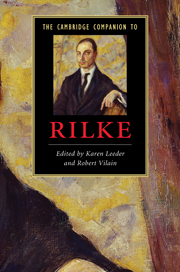Book contents
- Frontmatter
- Introduction
- PART I LIFE
- PART II WORKS
- PART III CULTURAL CONTEXTS, INFLUENCES, RECEPTION
- 8 Rilke and modernism
- 9 Rilke the reader
- 10 Rilke and the visual arts
- 11 Rilke: thought and mysticism
- 12 Rilke and his philosophical critics
- 13 Rilke’s legacy in the English-speaking world
- Appendix: Poem titles
- Guide to further reading
- Index
- Index of works
9 - Rilke the reader
from PART III - CULTURAL CONTEXTS, INFLUENCES, RECEPTION
Published online by Cambridge University Press: 28 July 2010
- Frontmatter
- Introduction
- PART I LIFE
- PART II WORKS
- PART III CULTURAL CONTEXTS, INFLUENCES, RECEPTION
- 8 Rilke and modernism
- 9 Rilke the reader
- 10 Rilke and the visual arts
- 11 Rilke: thought and mysticism
- 12 Rilke and his philosophical critics
- 13 Rilke’s legacy in the English-speaking world
- Appendix: Poem titles
- Guide to further reading
- Index
- Index of works
Summary
When considering Rilke's reception of the various literatures, ancient and modern, that were so familiar to him, we should expect a process of thoroughgoing assimilation and interiorisation rather than one of borrowing and imitation. A poem from The Book of Images, 'The Man Reading', shows how for Rilke the process of reading opens out the self, dissolving both the antitheses and contradictions of the external world and those between inner and outer life such that 'there outside' matches 'what I am living within' ('Dort drauben ist, was ich hier drinnen lebe', KA I, 332). The incommensurability of existence ceases to be disconcerting to the individual experiencing it, who mysteriously feels more interwoven with it than ever. The act of reading is an act of self-discovery rather than a process of collecting data about someone, something or somewhere else.
The next poem in the collection is called 'The Man Looking', clearly intended to function as a partner to 'The Man Reading'. Both open with an evocation of tempestuous weather, the storm in the second 'a transformer' ('ein Umgestalter') rendering the natural world it touches ageless, the landscape 'like a verse in the Psalter', likening the visual to the verbal. Reading and seeing were not as distinct for Rilke as might be expected. He will have been more than aware of the dual aspect of the word 'Bild' - as in the title of the collection, Buch der Bilder - which can be translated as 'picture' or 'image', the former anchored in the visual world, the latter also used of verbal constructs.
- Type
- Chapter
- Information
- The Cambridge Companion to Rilke , pp. 131 - 144Publisher: Cambridge University PressPrint publication year: 2010
- 2
- Cited by

